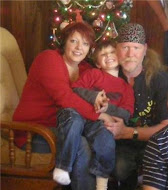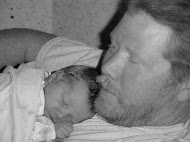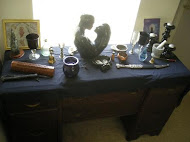Gingerbread houses, gingerbread cookies, gingerbread cookie crumbs left as a trail by the children in Hansel & Gretel. Gingerbread just seems to be very strongly linked to Christmas (ok, Yule for you purists *grin*) and to witches, Since I am a witch, writing about Christmas, and in particular Christmas Recipes as it is Tuesday again, gingerbread just seemed an obvious choice...This is the first time I've done a food post this way - but then again it's the first time I thought of it, and I actually (believe it or not, and I have no idea how it happened) have a little bit of spare time this morning, so I am going to include some "Gingerbread" facts & history. Lemme know whatcha think, if you like it I may start adding more like this...
The ginger plant originated in southeast Asia. The name "ginger" is derived from the Sanskrit "srngaveram" which means "horn root". In Medieval England, gingerbread simply meant "preserved ginger" and evolved from the Old French "gingebras" which came from "zingebar" the Latin name of the spice. It was only in the fifteenth century that the term came to be applied to a kind of cake made with treacle and flavored with ginger. Gingerbread has been baked in Europe for centuries. In some places, it was a soft, delicately spiced cake; in others, a crisp, flat cookie, and in others, warm, thick, steamy-dark squares of "bread," sometimes served with a pitcher of lemon sauce or whipped cream. It was sometimes light, sometimes dark, sometimes sweet, sometimes spicy, but it was almost always cut into shapes such as men, women, stars or animals, and colorfully decorated or stamped with a mold and dusted with white sugar to make the impression visible. In Medieval Europe, ginger was the second most highly traded spice after pepper. According to legend, Queen Elizabeth, 1st of England invented the "gingerbread man". and there remains more than one village tradition in England requiring unmarried women to eat gingerbread "husbands" at the fair if they are to stand a good chance of meeting a real husband.
From its very beginning gingerbread has been a fairground delicacy. Many fairs became known as "gingerbread fairs" and gingerbread items took on the alternative name in England of "fairings" which had the generic meaning of a gift given at, or brought from, a fair. The manufacture of gingerbread appears to have spread throughout Western Europe at the end of the eleventh century, possibly introduced by crusaders returning from wars in the Eastern Mediterranean. Gingerbread-making was eventually recognized as a profession in itself. In the seventeenth century, gingerbread bakers had the exclusive right to make it, except at Christmas and Easter. Similar cookies have a history that extends back to the Egyptians, but the style of the traditional Lebkuchen (from yourdictionary, a chewy cookie made with honey, spices, nuts, and candied fruits) probably was invented by Medieval monks in Franconia, Germany in the 13th century. The forerunner of today's Lebkuchen was called the "honey cake" and its history can be traced back to the Egyptians, the Greeks, and the Romans. They believed that honey, the only sweetener widely available to them, was a gift of the deities and had magical and healing powers. Honey cakes also were worn as a talisman in battle or as protection against evil spirits.
Of all the countries in Europe, Germany is the one with the longest and strongest tradition of flat, shaped gingerbreads. In Nuremberg, in the seventeenth century, gingerbread was not baked in the home, but was the preserve of an exclusive Guild of master bakers, the Lebkuchler. Nuremberg became known as the "gingerbread capital" of the world and as with any major trading center, many fine craftsmen were attracted to the town. Sculptors, painters, woodcarvers and goldsmiths all contributed to the most beautiful gingerbread cakes in Europe. Gifted craftsmen carved intricate wooden molds, artists assisted with decoration in frosting or gold paint. Incredibly fancy hearts, angels, wreaths and other festive shapes were sold at fairs, carnivals and markets. In 1571, French bakers of pain d'epices also won the right to their own guild, or professional organization separate from the other pastry cooks and bakers. In Paris a gingerbread fair was held from the eleventh century until the nineteenth century at an abbey on the site of the present St. Antoine Hospital, where monks sold gingerbread cut into the shape of pigs.
During the 19th century, gingerbread was modernized and romanticized when the Grimm brothers created the fairy tale about Hansel and Gretel. This story was about two children who were lost in the woods when they discovered a house made of bread, cake and candles. And let's not forget owned by an "evil" witch, who used it to lure unsuspecting children in. Lebkuchen are made throughout Germany and large pieces of lebkuchen are used to build Hexenhaeusle ("witches' houses," from the fairy tale Hansel and Gretel, also called Lebkuchenhaeusel and Knusperhaeuschen—"houses for nibbling at"). The
The english brought ginger to the American colonies early on. Gingerbread making in North America has its origins in the traditions of the many settlers from all parts of Northern Europe who brought with them family recipes and customs. By the nineteenth century, America had been baking gingerbread for decades. Ginger cookies were handed out to persuade Virginia voters to elect certain candidates for the House of Burgesses. Regional variations began occurring as more people arrived. In Pennsylvania, the influence of German cooking was great and many traditional Germany gingerbreads reappeared in this area, especially at Christmas time. The North and Midwest of America welcomed the Northern and Middle Europeans. At Christmas it is still very common in the midwest to have Scandinavian cookies like Pepparkaker or Lebkuchen. Often one can find wives holding "coffee kolaches" (coffee mornings) at which European ginger cakes still reign. No where in the world is there a greater repertoire of gingerbread recipes than in America - there are so many variations in taste, form and presentation. With the rich choice of ingredients, baking aids and decorative items the imaginative cook can create the most spectacular gingerbread houses and centerpieces ever.
GINGERBREAD:
- 2 1/2 tbsp. of golden syrup
- 1/2 cup of butter
- 1/2 cup of brown sugar
- egg yolk
- 2 cups of plain flour
- 1 tsp. of baking powder
- 3 tsp. of ground ginger
- 1/2 tsp. cinnamon, optional
- extra flour for rolling pastry
- currants, peel, cherries and a little icing
Stand container of golden syrup in hot water to soften. Beat the butter and sugar to a cream, then beat the egg yolk. Beat in the syrup. Slowly add flour, baking powder, ginger and optional dash of cinnamon. With floury hands, knead into a dough. Wrap in plastic and place in fridge for one hour, making it easier to roll out. Brush flour on the rolling pin and under the dough. Roll to an even 1 cm (1/8 inch) thick and cut out shapes. Place on a greased tray about 2 cm (1/4-1/2 inch) apart and bake in a moderately slow oven (180 degrees Celsius, 350 Fahrenheit) for about 12 minutes. Leave for a few minutes and remove with spatula.
Decorate with icing, peel, cherries, etc.
* Gingerbread Snowflakes *
From Gourmet Magazine's Favorite Holiday Cookie Recipes,
Active Time: 11/2 hour. Start to finish: 21/4 hour.
Ingredients:
- 2/3 cup molasses (not robust)
- 2/3 cup packed dark brown sugar
- 1 Tablespoon ground ginger
- 11/2 teaspoons ground cinnamon
- 1/2 teaspoon ground allspice
- 1/2 teaspoon ground cloves
- 2 teaspoons baking soda
- 2 sticks (1 cup) unsalted butter, cut into tablespoon pieces
- 1 large egg, lightly beaten
- 3 3/4 to 4 cups all-purpose flour
- 1/2 teaspoon salt
(Decorating icing recipe follows)
Special equipment:
- assorted 2- to 3-inch cookie cutters (preferable snowflake-shaped...what..? They're called SNOWFLAKE Cookies...lol)
- a metal offset spatula
- a pastry bag fitted with 1/8- to 1/4- inch plain tip (optional)
Preheat oven to 325°F
Bring molasses, brown sugar, and spices to a boil in a 4- to 5-quart heavy saucepan over moderate heat, stirring occasionally, and remove from heat. Stir in baking soda (mixture will foam up), then stir in butter 3 pieces at a time, letting each addition melt before adding next, until all butter is melted. Add egg and stir until combined, then stir in 3 3/4 cups flour and salt. Transfer dough to a lightly floured surface and knead, dusting with as much of remaining 1/4 cup flour as needed to prevent sticking, until soft and easy to handle, 30 seconds to 1 minute. Halve dough, then wrap 1 half in plastic wrap and keep at room temperature. Roll out remaining dough into a 14-inch round (1/8 inch thick) on a lightly floured surface. Cut out as many cookies as possible with cutters and carefully transfer with offset spatula to 2 buttered large baking sheets, arranging them about 1 inch apart. Bake cookies in upper and lower thirds of oven, switching position of sheets halfway through baking, until edges are slightly darker, 10 to 12 minutes total (watch carefully toward end of baking; cookies can burn easily). Transfer cookies to racks to cool completely. Make more cookies with remaining dough and scraps (re-roll once). Put icing in pastry bag (if using) and pipe or spread decoratively onto cookies. Cooks' note: Cookies keep in an airtight container at room temperature 3 weeks.
Makes about 4 dozen cookies.
Dawtch's note: It's been my experience making cookies that the re-roll, and original roll out using flour tends to dry out the dough making less tasty cookies. I always try to use a "flavored" dry ingredient for these chores - in the example of this recipe, I think I would use cinnamon - or at least cinnamon mixed generously into the flour.
Decorating Icing
Active time: 10 minutes. Start to finish: 15 minutes.
Note: Egg whites act as a stabilizer in this icing, allowing it to harden for decorating the cookies. Because the whites are not cooked, we prefer powdered egg whites, such as Just Whites, which are available in the baking section of most super-markets.
Ingredients:
- 1 (1-lb) box confectioners sugar
- 4 teaspoons powdered egg whites (not reconstituted)
- 1/3 cup water
- 1 Tablespoon fresh lemon juice
- 1 teaspoon vanilla
- Food coloring (optional)
Beat together all ingredients except food coloring in a large bowl with an electric mixer at moderate speed until just combined (about 1 minute.) Increase speed to high and beat icing, scraping down side of bowl occasionally, until it holds stiff peaks, about 3 minutes in a standing mixer or 4 to 5 minutes with a handheld. Beat in food coloring (if using). If you plan to spread (rather than pipe) icing on cookies, stir in more water, 1 teaspoon at a time, to thin to desired consistency.
Makes about 3 cups.
Speculoos or Belgian Spice Cookies
From Bon Appétit; December 1996)
Speculoos, a specialty of Belgium in which flat gingerbread cakes are cut into different shapes. Similar cookies called speculaas are made in Holland, Germany and Austria. These are decorated with melted white chocolate and some pretty red sugar.
Ingredients:
- 2 cups all purpose flour
- 1 tablespoon ground cinnamon
- 1 1/2 teaspoons ground ginger
- 1/2 teaspoon ground cloves
- 1/2 teaspoon baking powder
- 1/2 teaspoon salt
- 1 1/4 cups (packed) dark brown sugar
- 1/2 cup (1 stick) unsalted butter, room temperature
- 1 large egg
- 2 ounces good-quality white chocolate (such as Lindt or Baker's), melted
- Red colored sugar
Preheat oven to 350°F
Combine first 6 ingredients in medium bowl. Using electric mixer, beat brown sugar and butter in large bowl until light. Add egg and beat until fluffy. Gradually add dry ingredients and beat just until combined. Divide dough in half. Flatten each half into rectangle. Wrap with plastic; chill 1 hour. Lightly butter 2 large baking sheets. Roll out 1 dough piece on lightly floured work surface to 13 x 9-inch rectangle. Trim edges to form 12x8-inch rectangle. Cut into 24 4x1-inch rectangles. Lightly press miniature cookie cutter into each rectangle to make imprints (do not cut through dough). Arrange cookies on prepared baking sheets, spacing 1 inch apart. Bake until edges begin to darken, about 8 minutes. Transfer cookies to rack and cool. Repeat with remaining dough piece.
Working with 1 cookie at a time, brush imprints with melted white chocolate. Sprinkle colored sugar generously over chocolate. Let stand until chocolate sets, about 2 hours. Shake off excess colored sugar. (Can be made ahead. Store in airtight container at room temperature up to 1 week, or freeze up to 1 month.)
Makes 4 dozen.
* CHEWY CHOCOLATE GINGERBREAD COOKIES *
From Martha Stewart's well-organized and very-perky and really commercial website:
Ingredients:
- 7 ounces best-quality semisweet chocolate
- 1 1/2 cups plus 1 tablespoon all-purpose flour
- 1 1/4 teaspoons ground ginger
- 1 teaspoon ground cinnamon
- 1/4 teaspoon ground cloves
- 1/4 teaspoon ground nutmeg
- 1 tablespoon cocoa powder
- 8 tablespoons (1 stick) unsalted butter
- 1 tablespoon freshly grated ginger
- 1/2 cup dark-brown sugar, packed
- 1/2 cup unsulfured (not treated or preserved with sulfur) molasses
- 1 teaspoon baking soda
- 1/4 cup granulated sugar
Line two baking sheets with parchment. Chop chocolate into 1/4-inch chunks set aside. In a medium bowl, sift together flour, ground ginger, cinnamon, cloves, nutmeg, and cocoa. In the bowl of an electric mixer, fitted with the paddle attachment (yeah, we all have one of those...), beat butter and grated ginger until whitened, about 4 minutes. Add brown sugar; beat until combined. Add molasses; beat until combined. In a small bowl, dissolve baking soda in 1 1/2 teaspoons boiling water. Beat half of flour mixture into butter mixture. Beat in baking-soda mixture, then remaining half of flour mixture. Mix in chocolate; turn out onto a piece of plastic wrap. Pat dough out to about 1 inch thick; seal with wrap; refrigerate until firm, 2 hours or more. Heat oven to 325°. Roll dough into 1 1/2- inch balls; place 2 inches apart on baking sheets. Refrigerate 20 minutes. Roll in granulated sugar. Bake until the surfaces crack slightly, 10 to 12 minutes. Let cool 5 minutes; transfer to a wire rack to cool completely. Makes 2 dozen.
* GINGERBREAD MEN & WOMEN *
from Edain McCoy's book:
"The Sabbats: A New Approach to Living the Old Ways"
Ingredients:
- 1 cup brown sugar, packed
- 1 cup dark molasses
- 3/4 cup shortening
- 1/4 cup butter or margarine
- 4 cups flour
- 2 eggs, slightly beaten
- 2 teaspoons cinnamon
- 3/4 teaspoon powdered cloves
- 1/8 teaspoon allspice
- 4 teaspoons ginger
- 1 1/2 teaspoons baking soda
Preheat oven to 350 degrees F. Mix all ingredients except the flour. Add the flour slowly, mixing each addition thoroughly. The dough should be slightly stiff. If the mixture seems too dry, add a teaspoon or two of water; if too wet, add more flour. Roll out the dough on a floured cutting board to about a 1/4-inch thickness. Use cookie cutters shaped like little dough people to make the shapes. Place these on a lightly greased cookie sheet and bake for 10 minutes (time is only approximate). Transfer the cookies to wax paper to cool. Give your gingerbread people features by using colored frosting from a pastry tube.
(Makes about 3 dozen medium-sized cookies)
Additional Sources:
Disclaimer: No one involved in this blog or its contents may be held responsible for any adverse reactions arising from following any of the instructions/recipes on this list. It is the reader's personal responsibility to exercise all precautions and use his or her own discretion if following any instructions or advice from this blog.















No comments:
Post a Comment